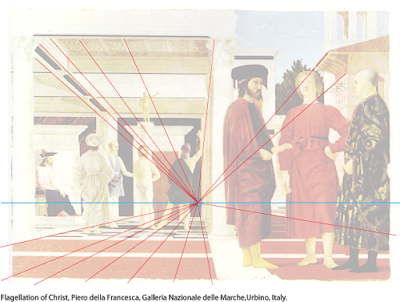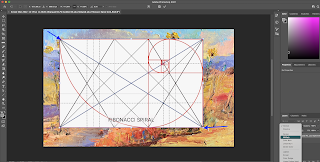A Mathematician Paints: Perspective Part 1
Introduction
Many artists have studied and learned 1-point perspective early on. I've assumed that all artists understand how to use its rules. But do they (we) care? Isn't it so obvious that it's actually ingrained in us while we paint? I am choosing to assume that it's not obvious. But even more important, does it matter? Or perhaps, even more importantly, is there a difference between knowing the simple rule and understanding the theory behind it? Would it help the artist to know for example that perspective was considered an important or revolutionary notion historically? Or would knowing the underlying mathematics provide the artist with a deeper, understanding?I probably dabbled with perspective in grammar school and high-school. I don't really remember. I am planning to put together a lesson plan for my 10-12 year old grandchildren while they do their on-line learning from home during the pandemic. And they can have fun with it.
But my first memory of persepctive in art classes occurred during the Introduction to Art History while I was in college at New York University. I can remember vividly the large class with slides showing works of artists beginning with the caveman. We used Jansen's classic text. In particular though I can visualize the session dedicated to explaining the difference between religious art, with its emplasis not on realism, but rather on highlighting the imprtance of religious figures by using size rather than accuracy; the larger the image the more important. Also: "In the medieval period the glorification of God and the illustration of biblical themes were the purposes of painting. Gilt backgrounds suggested that the people and objects portrayed existed in somehavenlly region". The painters produced forms that were flat and unnatural. Eventually though the depiction of the real world became the goal. .... Artists began to consider the mathematical problem of representing the three-dimennsional world in two dimensions.1-Point Perspective
Artists such as Piero della Francesca began to use a vainishing point in their paintings. Floor tiles were very helpful with this. And of course, a main figure would be centered at the vanishing point. This all seems fairly straightforward, even boring. However when I picked up a book from my personal library, Mathematical Thought from Ancient to Modern Times by Morris Kline, I read how important the development of perspective was in history. And the history is fascinating, with familiar names from the times of the Greeks through Pascal. Topics such as Geometry and Projective Geormety were mentioned and I became absorbed in reviewing the history. Side note: Morris asked me to substitute teach for him while I was a graduate student at the Courant Institute of Mathematical Sciences. I covered topics such as Perspective, Astronomy and non-Euclidan Geometry (think Buckminstrer Fuller's Geodesic Domes) in these classes.
Of note throughout the discussion was that the theory of perspective was driven by painters!!
So imagine that the artist is looking at a scene as far as the eye can see. Then he places a sheet of glass between the scene and his eye, with the glass representing a canvas as close to it as possible. The artist then would hope to paint on the canvas exacly what is seen on the glass. If one imagines lines going trom the eye, interecting the glass or the canvas, then paint strokes can be placed on the canvas where the lines interesect the glass. In this way, the artist can paint a more realistic scene, translating 3-dimenional realisty to the flat 2-dimensional canvas. Do you recall the image of Duerer with his painting of himself with an aid of a perspecitive tool: (from Wikipedia) "Taking his cue from Leon Battista Alberti (1404 –1472) and Piero della Francesca (1415–1492), Dürer began to introduce the 'secret art of perspective' into his works. ... [1] He used measurement and geometry to produce images that created the illusion of depth in a flat pictorial-plane.
Vanishing point in a Piero della Francesca painting:

And the final painting:
Informal Perspective
Today I read Drawing on the Right Side of the Brain by Betty Edwards. In the past I used the book for contour drawing. But I see that it has examples relevant to a discussion of Perspective. She uses a technique labeled "sight" plus a View Finder that she constructed out of a plastic for the artist to use as a layer of 'glass' between a photo and the drawing that is to be constructed. One may mark a unit length on it and verticals and horizontals before drawing a scene. She notes that artists might find using this tehnique difficult but that it shold help create more accurate paintings. She also notes that she feels that this is easier to use than formal perspective. I will keep this in mind as I explore perspective further. We have worked up to now with what we might call 1-point perspective. Let us turn to 2-point perspecive now.
2-Point Perspective
Basically a simple example of a scene that would utilize 2-point perspective would be buildings that are turned 45 degrees as seen by the artist One side is lined up facing one vanishing point while the other leads to the second point. The tops of the 'walls' would each go to the two points successively as would the bottoms of the walls. I chose this image randomly from a list found through googling, 2-Point Perspective.




